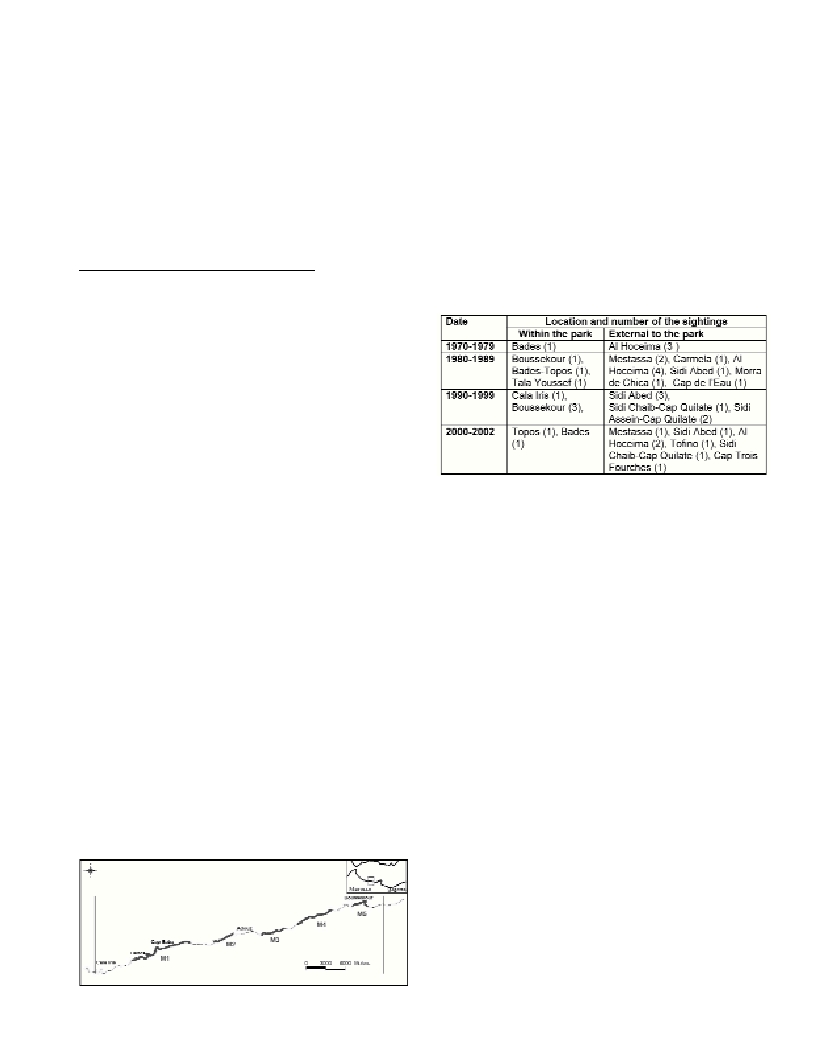HABITAT SUITABILITY AND SIGHTINGS OF THE MEDITERRANEAN MONK SEAL
IN THE NATIONAL PARK OF AL HOCEIMA (MOROCCO)
G. Mo
1 *
, H. Bazairi
2
, E. Salvati1, S. Agnesi
1
, A. Limam
3
, L.D. Nachite
4
, C. Rais
3
, I. Sadki
5
, L. Tunesi
1
, N. Zine
6
1
ICRAM, Rome, Italy - * giulia_mo@virgilio.it
2
Université Hassan II Aïn Chock, Casablanca, Morocco
3
RAC/SPA, Tunis, Tunisia
4
Université Abdel Malek Essaadi, Tetouan, Morocco
5
Université Ibnou Zohr, Agadir, Morocco
6
Université Meknes, Morocco
Abstract
Coastal habitat suitability and Monachus monachussighting information was collected in the National Park of Al Hoceima (Morocco).
Two coastal sectors have caves that are most suitable for the species. Fishermen interviews indicate the species’historical and recent
presence in the park and external areas.
Keywords: Mediterranean monk seal, Morocco
Rapp. Comm. int. Mer Médit., 37,2004
538
Introduction
A significant information gap exists on Mediterranean monk seal
(Monachus monachus) distribution along north African coasts (1).
Consideration of these areas is crucial for a species conservation strat-
egy (2) and identification and recovery of small groups should be
undertaken. Seal presence in the last decades hypothetically occurred
between Al Hoceima and Cap des Trois Fourches (3) and the popula-
tion may consist of 10 individuals (1). This study enriches the knowl-
edge of the coastal habitat suitability and provides an update on
M.monachussightings in the National Park of Al Hoceima.
Methods
The terrestrial National Park of Al Hoceima is situated about 50 km
from the Straits of Gibraltar with a 47 km long coast. Fieldwork was
undertaken within the MedMPA project, coordinated by UNEP-
MAP’s RAC/SPA and funded by the EC. Information on monk seal
coastal habitat and sightings was collected, during summers 2002 and
2003. Rocky cliff sectors were first identified and subsequently aquat-
ically investigated to verify for caves. Cave characteristics (protection
from wave action, elevation of emerged beach, difficulty in observing
the cave from the outside, protection from exposure to major motor
traffic) were analysed in terms of their capacity to confer protection
and these were ranked (1 =low, 2=medium, 3=high). Caves with high-
est ranking represent optimal locations for the species. Information on
M.monachussightings was collected by interviewing fishermen
operating from the park’s landing sites and to the east until Sidi Chaib
(20km). The questionnaire collected information on fishing activities
and seal sightings through the use of cards (4) depicting images of
other marine species as well.
Results
The area has rocky calcareous cliffs forming steep overhangs alter-
nated to rock slides and pebble beaches. Five sectors of rocky coast
(M1-M5) present medium-large fractures (Fig.1). Sectors M1-M3
are of compact dolomitic limestone while sectors M4 and M5 appear
composed of bent strata of limestone. Sectors M1-M4 were fully
inspected. 25% of sector M5 was inspected due to logistical difficul-
ties. Small caves (<3mx3m), visible from sea, were disregarded. Eight
caves were identified: one in M2, three in M3, two in M4 and two in
M5. The obtained ranking was: high for two in M3 and one in M4,
intermediate for two in M5 and low for the remaining caves. Forty-
five fishermen were interviewed. M. monachuswas recognised by 35
of the interviewees and of these observations, 9 occurred in the peri-
od 2001-2002. Table 1 indicates the areas in which interviewees
reported observing seals.
Discussion
The study area has interesting physical coastal habitat for the
species. Sectors M3 and M4 have caves that are most suitable for
M.monachusand require adequate protection and monitoring meas-
ures. The observations drawn from the interviews indicate the histor-
ical and recent presence of M. monachusin the coastal stretch of the
study area, confirming the need for a species-specific conservation
plan. Various sightings reported in areas external to the park, as east
as Cap de l’Eau and as far as Tofino, (18nm north of Al Hoceima)
highlight the need to conduct further investigations and conservation
initiatives in a wider geographical area, still appearing to host monk
seal individuals.
Special thanks are extended to T. DiNora, M. Manca, E. Piccione,
the Ministère des Eauxs et Forets, the National Park of Al Hoceima,
and I.T.P.M. for their assistance.
References
1-Aguilar A., 1998. Current status of Mediterranean monk seal
populations. In: Meeting of experts on the implementation of the Action
Plans for marine mammals (monk seal and cetaceans) adopted within
MAP. Arta, Greece, 29-31 October 1998. UNEP (OCA)/MED WG.146/4.
2-Reijnders P.J.H., 1998. Vulnerability of small Mediterranean monk seal
groups and conservation policy. Meeting of experts on the implementation
of the Action Plan for marine mammals (monk seal and cetaceans)
adopted within MAP. Arta, Greece, 29-31 October 1998.
3-Bayed A., and Beaubrun P.C., 1987. Les mammifères marins du
Maroc: Inventaire préliminaire. Mammalia, Fr., 51: 437-446.
4-Boyd I.L., and Stanfield M.P., 1998. Circumstantial evidence for the
presence of monk seals in the West Indies. Oryx 32(4): 310-316.
Fig.1. Rocky sectors (M1-M5) of the study area.
Table 1. Monk seal sightings recorded through interviews.

